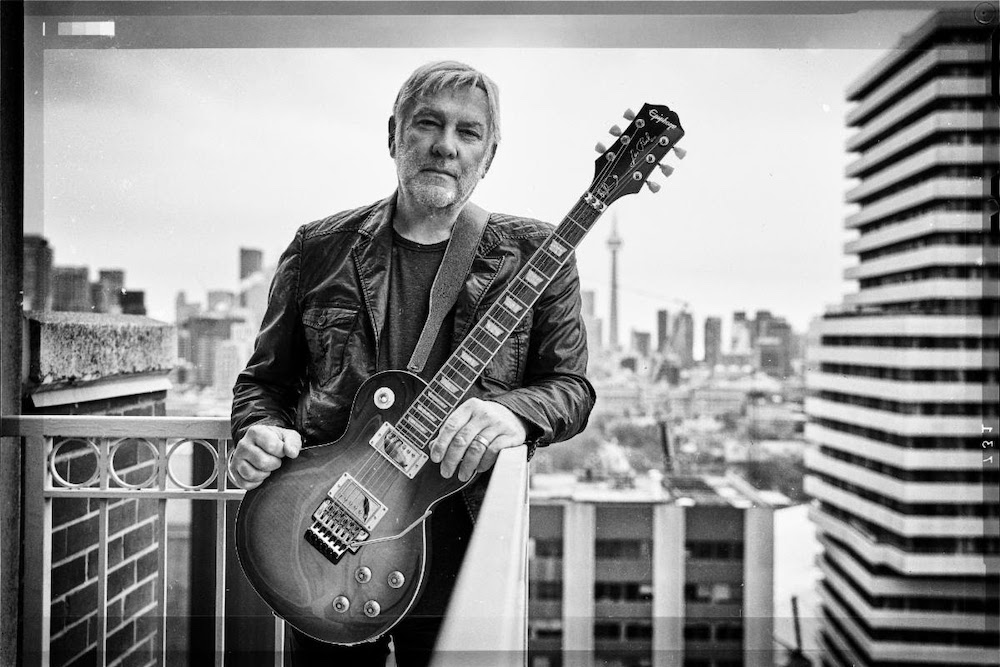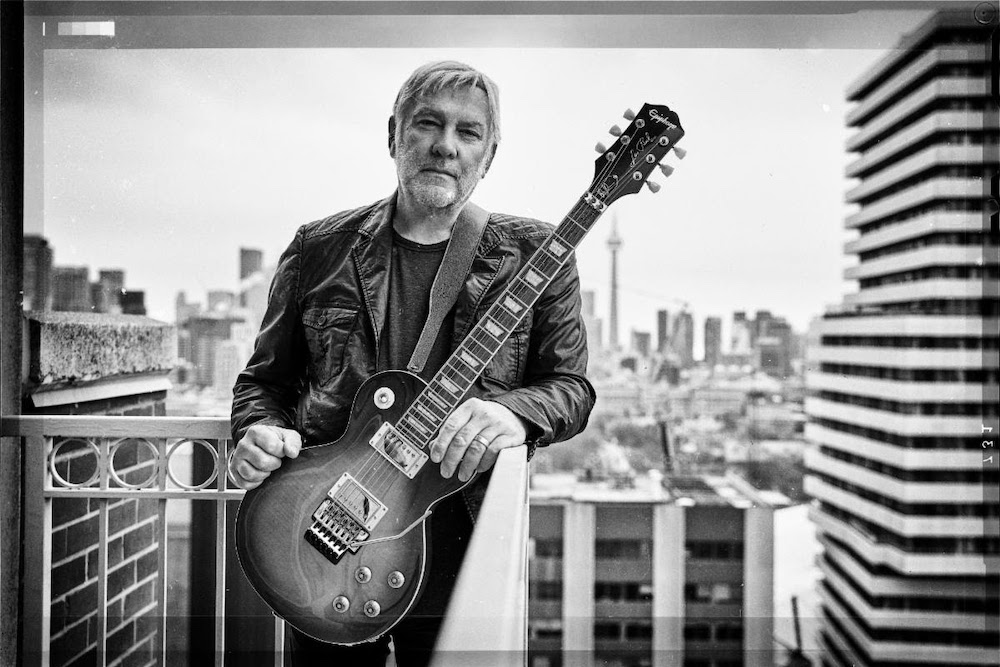

Alex Lifeson didn’t have some grand master plan for all of this: the glossy-looking website, the big rollout of new music, the subsequent parade of interviews.
But the dominos just keep tumbling, and he’s going with the flow. With the launch of his new signature Epiphone electric guitar, the Alex Lifeson Les Paul Axcess Standard, he finds himself in a rare solo spotlight — probably the most attention he’s faced since Rush retired from touring in 2015.
“I stayed away from social media forever,” he tells SPIN. “I really wanted to protect my privacy and wasn’t really interested in doing all the things that are required because I’m generally a lazy person. But now with the Epiphone account, with the demand of creating an Instagram and my own website, I’m going to try to utilize those things and make them active — definitely as a source for any musical ideas I might have had.”
Lifeson spoke to SPIN about some of those ideas, an upcoming collaborative project called Envy of None and a “really cool” reissue of Rush’s Moving Pictures.
You recently told Sweetwater that you wrote a “half-dozen” songs after the last Rush tour, including one with a country feel and one that’s kinda psychedelic. Was “Kabul Blues” the psychedelic track in question?
Alex Lifeson: Yeah, “Kabul Blues,” that’s the way it started out. I was fiddling around, recording some stuff, and I wanted to do something bluesy — I love playing that kind of stuff. As it developed and I started messing around with the arrangement, it started to take on this kind of Eastern feel. I thought, “Let me try throwing on some cool sound effects and backward guitar parts,” and it started getting much more psychedelic. I thought the combination of those three elements was really interesting — and, more importantly, really fun for me to play and listen to over and over again.
The textural, atmospheric quality of that song reminds me a lot of the last couple Peter Gabriel albums.
I like the way it turned out. The psychedelic nature of it was really a lot of fun — creating weird sounds and backwards moments and tones as a backdrop to a blues song with this interesting flavor. It’s kind of unique to my ear. I just love listening to great sounds. Whatever order they’re in — there are no rules. It’s just creating this piece of music where you always find something else in it. That’s a good example of it.
Can you tell me about the country song? I’m dying to hear an Alex Lifeson country song sounds like.
The country thing is called “Western Sunset,” and it started out as something I was feeling when I heard about [the death of] Neil [Peart]. It’s a very thoughtful, very calming arrangement and song. It’s very, very different for me. That was a cool thing. [Envy of None’s] Maiah Wynne’s going to do some vocal musings — no lyrics, just sounds — that I think will enhance what’s already there. Andy [Curran] played bass on it, and David [Quinton Steinberg] played drums on it. It’s more traditional country and western — it’s not modern country or anything like that. It has a very lonesome big-sky feel to it.
And then “Spy House” was another exercise in riffing and building up tracks and using some samples and vocal ideas and orchestral things in a very short platform. It’s really a lot of fun. Now that I have the website, I’d like to add to it. I’ve been recording stuff for the last three years that I’ve only kept to myself and haven’t released. They’re mostly demos, but they’re pretty advanced, so I’d like to start adding those to my website, just for the listening interest of anyone who wants to take the time.
You recently told Make Weird Music that you’ve been interested for a while now in releasing some of your unfinished recordings — sort of like what Steve Howe has done with his own home recording series. Is that idea still on the table?
Absolutely. That’s exactly it. When I heard that Steve was doing that, I thought, “That’s a great idea.” With him, it’s essentially just ideas he put down — a mix of demos and less demo-like [ideas]. With a lot of these, it’s starts out as a guitar demo, but then I add drums — either real or sampled drums — and create drum patterns. I put on some bass on whatever [else]. A lot of these songs are more finished in that sense. But they’re markers for that time and where I was personally, musically — not so much a Rush thing, but me personally. It would be a lot of fun to share that stuff.
With those things, it’s good to take them to a point — they sound really good to listen to, and maybe you play them for your friends. But it’s a different step if you want to make it into an album. It’s much more complicated. These are things I was doing on my free time or between tours, so it’s more indicative of my playing or writing.
Andy has said that you have 10 songs in total for Envy of None. Are any of these other ideas we’ve been talking about planned for that project?
Right now, the Envy of None material as an album is what we’re focused on. We’re mixing right now. We’re really happy with the way it’s developing. It’s much more challenging to get a record deal. That doesn’t really exist in 2021. We’re trying to find what the best vehicle of exposure would be for this. But in the meantime, we’re finishing up the mixes and getting it in good sonic shape. With the other material, I’ve been living with it for so long that I’d like to release it in dribs and drabs on my website. I don’t think there’s any big need for me to create a package of all this material — it’s just fun to share it, whereas the Envy of None stuff is a little more serious and more for an effort that we’re all working on.
I also wonder if part of having a project with other people, where you can enter something with a foundation, would be a little less exhausting or intimidating than a solo album where you’re running the show by yourself.
Yeah, it’s a lonely road working on a solo record. And it’s hard to be objective for the whole thing — to tell if you’re doing something worthwhile and worth listening to. The exciting thing about this is you share files, and it grows and evolves. Every time somebody adds something, it’s inspiring to re-do something or add something else. The whole recording experience is a lot of fun with this project. It differs a little from Rush — we were so much more intensive about the way we did things. We worked together all the time in very close quarters, and in very concentrated time. This has been spread out over a number of years. And because it’s four very individual players, it’s been great to see the kind of evolution it’s taken.
Rush fans seem to really be enjoying the anniversary reissue series, but since the 40th anniversary of Moving Pictures has come and gone, we’re all wondering if that one is going to happen. Do you have any kind of package planned?
It’s not so much that we’re doing it, but there are a lot of plans that have been developing. A lot of stuff floats to us for approvals and comments, but yes, there is a package and it’s quite extensive. From what I’ve seen, it looks really, really cool. Can you believe it’s been 40 years? I feel so old. All of the stuff is really, really cool.
Geddy Lee has famously said that there’s nothing in the Rush vaults — including unreleased songs — because you guys were very efficient about only recording the material you finished. I figured I’d ask you. So…nothing?
No. Nothing. Nothing. It’s true. We wrote what we set out to write for that album, and that’s all there was. We never did multiple tracks, like so many record companies would demand from other bands. Write 20 songs and we’ll take the 12 best.
You’ve been really busy lately. Any other projects we can look forward to?
I’ve done a few little projects here and there. I did a thing with Kirk Hammett and Tom Morello. [Morello said], “Fill it up with guitar” — then he sent back a file with everything we did. He’s such a great player and a wonderful person. I smiled the whole time listening to it.


Leave a comment